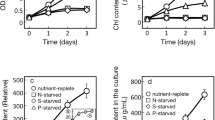Abstract
To understand the utilization property of light energy,Synechococcus sp. MA19, a poly-β-hydroxybutyrate (PHB) producer, was cultivated at the different incident light intensities of 15.3, 50.0 and 78.2 W/m2 using media with and without phosphate. From the results of metabolic flux analysis, it was found that the cell yield based on ATP synthesis was estimated as 3.5×10−3 kg-biomass/mol-ATP in these cultures. Under the examined conditions, there were no significant differences in the efficiency of light energy conversion to chemical energies estimated as ATP synthesis and reducing potential (NADH+NADPH) formation whether the PHB synthesis took place or not. The energy converted from light to ATP was kept relatively high around the energy absorbed by the cells of 2.5–3.0×106 J h−1 kg−1, whereas the energy of reducing potential was hardly changed in the examined range of the energy absorbed by the cells.
Similar content being viewed by others
References
Campbell, J. III, S. E. Stevens Jr., and D. L. Balkwill (1982) Accumulation of poly-β-hydroxybutyrate inSpirulina plantensis.J. Bacteriol. 149: 361–363.
Stal, L. J. (1992) Poly(hydroxyalkanoate) in cyanobacteria: an overview.FEMS Microbiol. Rev. 103: 169–180.
Nishioka, M., K. Nakai, M. Miyake, Y. Asada, and M. Taya (2001) Production of poly-β-hydroxybutyrate by thermophilic cyanobacterium,Synechococcus sp. MA19, under phosphate-limited conditions.Biotechnol. Lett. 23: 1095–1099.
Miyake, M., M. Erata, and Y. Asada (1996) A thermophilic cyanobacterium,Synechococcus sp. MA19, capable of accumulating poly-β-hydroxybutyrate.J. Ferment. Bioeng. 82: 512–514.
Aiba, S. and M. Matsuoka (1979) Identification of metabolic model: citrate production from glucose byCandia lipolytica.Biotechnol. Bioeng. 21: 1373–1386.
Vallino, J. J. and G. Stephanopoulos (1993) Metabolic flux distribution inCorynebacterium glutamicum during growth and lysine overproduction.Biotechnol. Bioeng. 41: 633–646.
Shi, H., M. Shiraishi, and K. Shimizu (1997) Metabolic flux analysis of poly-(β-hydroxybutyric acid) inAlcali-genes astrophus from various carbon sources.J. Ferment. Bioeng. 84: 579–587.
Takiguchi, N., H. Shimizu, and S. Shioya (1997) An on-line physiological state recognition system for the lysine fermentation process based on a metabolic reaction model.Biotechnol. Bioeng. 55: 170–181.
Hua, Q., P. C. Fu, C. Yang, and K. Shimizu (1998) Microaerobic lysine fermentation and metabolic flux analysis.Biochem. Eng. J. 2: 89–100.
Yang, C., Q. Hua, and K. Shimizu (2000) Energetics and carbon metabolism during growth of microalgal cells under photoautotrophic, mixotrophic and cyclic lightautotrophic/dark-heterotrophic conditions.Biochem. Eng. J. 6: 87–102.
Yang, C., Q. Hua, and K. Shimizu (2002) Quantitative analysis of intracellular metabolic fluxes using GC-MS and two-dimensional NMR spectroscopy.J. Biosci. Bioeng. 93: 78–87.
Rippka, R., J. Deruelles, J. B. Waterbury, M. Herdman, and R. Y. Stanier (1979) Genetic assignments, strain histories and properties of pure cultures of cyanobacteria.J. Gen. Mcrobiol. 111: 1–61.
Hirata, S., J. Hata, M. Taya, and S. Tone (1997) Growth estimation ofSpirulina plantensis by considering light distribution in photoautotrophic batch culture.J. Chem. Eng. Jpn. 30: 355–359.
Hata, J., Q. Hua, C. Yang, K. Shimizu, and M. Taya (2000) Characterization of energy conversion based on metabolic flux analysis in mixotrophic liverwort cells,Marchantia polymorpha.Biochem. Eng. J. 6: 65–74.
Vallino, J. J. and G. Stephanopoulos (1990) Flux determination in cellular bioreaction networks: application to lysine fermentation. pp. 205–219 In: S. K. Sikdar, M. Bier, and P. Todd (eds.).Frontiers in Bioprocessing. CRC Press, Boca Raton, FL, USA.
Stumpf, P. K. and E. E. Conn (1980)The Biochemistry of Plants. Vol. 2. pp. 1–27. Academic Press, New York, NY, USA.
Holms, W. H. (1986) The central metabolic pathways ofEscherichia coli: relationship between flux and control at a branch point, efficiencies of conversion to biomass, and excretion of acetate.Curr. Topics Cell. Reg. 28: 69–105.
Ingraham, J. L., O. Maaloe, and F. C. Nedhardt (1983)Growth of the bacterial Cell. pp. 87–173. Sinauer Associates, Sunderland, MA, USA.
Rawn, J. D. (1989)Biochemistry. Neil Patterson, Publishers, Burlington, NC, USA.
Author information
Authors and Affiliations
Corresponding author
Rights and permissions
About this article
Cite this article
Nishioka, M., Nishiuma, H., Miyake, M. et al. Metabolic flux analysis of a poly-β-hydroxybutyrate producing cyanobacterium,Synechococcus sp. MA19, grown under photoautotrophic conditions. Biotechnol. Bioprocess Eng. 7, 295–302 (2002). https://doi.org/10.1007/BF02932839
Received:
Accepted:
Issue Date:
DOI: https://doi.org/10.1007/BF02932839




